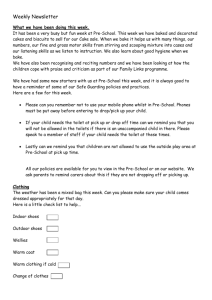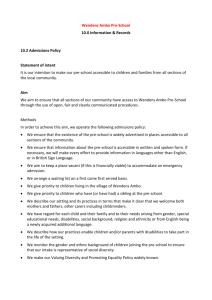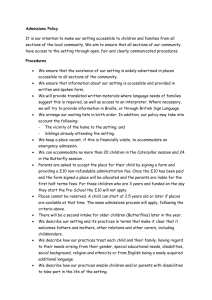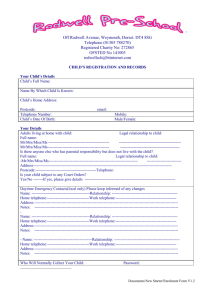Pre-Kindergarten BOE Presentation 11-19-13
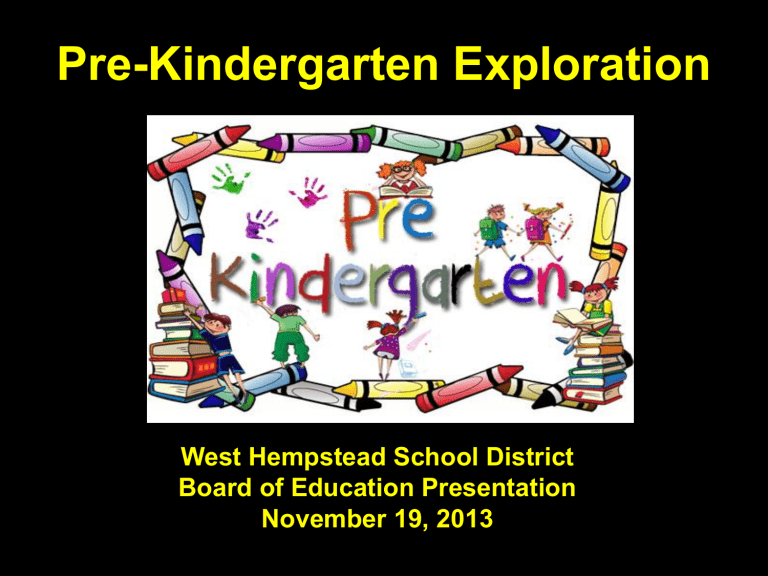
Pre-Kindergarten Exploration
West Hempstead School District
Board of Education Presentation
November 19, 2013
Strategic Plan 2011-2014
Academic
Excellence
Use of Data
To Improve
Instruction
Raising Student
Achievement
Educational
Equity
Educational
Technology
Community
Relations
Educational Equity Action Plan
• Examine the need and feasibility of a pre-school program
• Visit programs
• Investigate pre-school options
• Research success of this early intervention in the literature
The Need
• 34% of the current kindergarten students have no preschool experience (range from
31%-38% over the past four years)
• The 2013 average incoming screening score
(including motor, language and concepts):
51% for students without pre-school
77% for students with pre-school (51% higher than students without pre-school)
Visitations
• Westbury
• Freeport
• Long Beach
• Herricks
• Oceanside
• Lawrence
• Franklin Square
Models
• Funding: UPK, District, UPK/District,
Parents Pay (scholarships available)
• Providers: District staff or outside contractors (Harbor Day, St. Joseph’s
College, SCOPE)
• Length of Day: half day, full day, optional length of day
Classroom Set-up
Program Components:
Group Time
Center Time
Literacy
Numeracy
Blocks
Dramatic Play
Movement
Music
Artistic Expression
Collaboration with Families
Benefits:
• Exposure to the “Language” of School
• Experience with the “Routines” of School
• Expansion of Background Knowledge
• Foundation in Academic Vocabulary
• Initial Foundation in the Common Core
Curriculum
• Socialization and Learning through Play
• Closing the Achievement Gap Through Early
Intervention
Projected Costs
• One-time Start up Costs:
--development of space
--classroom set-up ($8,000-$10,000 per classroom —4 classes/2 classrooms
$16,000- $20,000)
• Recurring Costs:
--per-pupil cost can range from $2,700-
$6,000 per student per year,
--depending on the model selected
(4 classes/64 students--$172,800-$384,000)
Next Steps
• Decide whether to proceed with exploration
• Continue to examine research
• Choose a model and determine cost of program
• Determine number of students to be served
• Determine cost of developing space
• Explore funding sources
• Identify selection process
• Develop curriculum
The Big Questions…
Are we ready to open the door of opportunity for all students by building a strong pre-school foundation?
Do we believe that pre-school can help to close the equity gap?
How will we fund the program?
Do we fund Pre-K before we consider restoring/filling in what has been lost?
What does the research say?
• Stanford University: the achievement gap starts as early as 18 months, by age five there can be a twoyear gap.
• Dickinson ( Vanderbilt ) and Snow ( Harvard ) —a child’s vocabulary score in kindergarten can predict reading comprehension scores in later grades.
• Fernald and Weisleder ( Stanford ) —there is a wide discrepancy between the number of “child-directed” words heard per day by pre-schoolers (670 vs.
12,000). Children who hear more words have larger vocabularies by age two. There is a correlation between strength of vocabulary and literacy development in children.
Research continued….
• Pianta, University of Virginia —after receiving high-quality Pre-K, at risk students demonstrated the same achievement levels as their peers without risk factors.
• Gormley, Georgetown University —Preschool education has considerable potential to improve educational outcomes for Hispanic children.
What does our data tell us?
• Language and concept scores on the kindergarten screening indicate a significant discrepancy between the students who have attended pre-school and those who have not attended pre-school.
• The number of letters and sounds that students can identify upon entering kindergarten is significantly different for the two groups of students.
• Additional factors such as ELL and poverty exacerbate the discrepancy between the two groups of students.
Are we ready to launch a developmentally-appropriate pre-kindergarten option?



